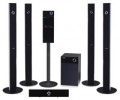Front (RMS)
Rated output of one front channel of a home theater system. This paragraph indicates the power of the complete front speaker, however, it can also be used to determine the characteristics of the built-in amplifier — its rated power on a particular channel (not necessarily the front one), usually, slightly exceeds the power of the corresponding speaker.
Rated power in this case is the highest average (root mean square, RMS) sound power that the speaker is capable of delivering for an unlimited time, working without failures and overloads. Individual signal jumps can be stronger, but the power of acoustics is determined precisely by RMS.
The
higher this indicator(regardless of whether we are talking about front or some other speakers) — the louder the speakers, the better they are suitable for large rooms. At the same time, in a small room, too high power may be unnecessary, because. operating the speaker at full volume will cause discomfort — despite the fact that powerful acoustics also have the appropriate dimensions, weight and price. More detailed recommendations on the optimal power of the speaker components, depending on the characteristics of the situation, can be found in special sources.
Rear (RMS)
Rated output of one home theater rear channel. For more information about the meaning of this parameter, see "Front" above.
Centre (RMS)
Rated power of one centre channel of a home theater. For more information about the meaning of this parameter, see "Front" above.
Subwoofer (RMS)
Rated power of the subwoofer supplied with the home theater. See "Front" above for details on power rating; here we note that subwoofers often have a fairly high power, because. they are designed to cover low frequencies in all audio channels.
Total power (RMS)
The total power rating of all home theater speakers, including subwoofers. The value of the rated power is described in detail in paragraph "Front" above.
Wireless connection
The ability to connect speakers to the base via a
wireless interface — most often a radio. The main advantage of this connection is the absence of connecting wires, which significantly limit the movement of the speakers and can interfere, getting confused with each other and with other wires. The disadvantages of wireless speakers are often lower sound quality than wired counterparts, as well as high cost.
Bass reflex
The phase inverter is a tube installed in the column housing and having an outlet to the surrounding space. Most often, this feature is found in subwoofers, although it can also be used in main acoustics. The length of the tube is chosen so that a signal comes out of the outlet, inverted in phase relative to the signal from the front of the diffuser. This increases the sound pressure and improves the sound of the speakers, however, it can create certain side effects (in particular, associated with the hum of the air flow in the bass reflex pipe). Therefore, the presence or absence of this function is not a clear advantage — it all depends on the preferences of the listener and the design features of a particular speaker.
Active subwoofer
Subwoofer with its own built-in power amplifier. The presence of such an amplifier allows you to "unload" the main amplifier of the cinema, which has a positive effect on the overall volume and sound quality of the speaker system. In addition,
active subwoofers are often equipped with fine-tuning tools that allow you to achieve the desired sound quality without moving the subwoofer around the room.
Media format
An optical disc format supported by the built-in home theater drive.
—
CD/DVD. Optical discs of small (CD) and medium (DVD) capacity. The former are well suited for recording music, but a full-length film on such a medium can only be recorded in low quality. The latter allow you to record both music and video in medium and even high resolution. CD and DVD are supported by all home theater models capable of reading optical discs.
—
Blu-ray. High-capacity optical discs designed specifically for recording large volumes of information, in particular high-definition video (including 3D) combined with multi-channel sound. However to fully view Blu-Ray discs, you need not only a player, but also a TV that supports the appropriate resolutions and capabilities.

